For a quick boost, a 10- to 20-minute power nap is ideal, helping you feel alert and refreshed without grogginess. If you need longer rest and want full recovery, aim for around 90 minutes, allowing your body to complete a full sleep cycle. Short naps are great for busy days, while longer ones benefit deeper rest and memory. Keep in mind that timing and environment matter—if you want to know more, there’s plenty to contemplate.
Key Takeaways
- Short naps of 10-20 minutes boost alertness and focus without causing grogginess.
- Longer naps of about 90 minutes allow for complete sleep cycles, supporting memory and physical restoration.
- Napping early afternoon (1-3 pm) aligns with natural circadian rhythms for optimal benefits.
- Avoid late-day naps to prevent interference with nighttime sleep and reduce sleep inertia.
- Personal needs and cultural norms influence ideal nap length; monitor how you feel after different durations.
Understanding the Benefits of Napping

Napping offers numerous health benefits that can boost your overall well-being. Historically, many cultures incorporated napping into daily routines, recognizing its restorative power. Ancient Egyptians and Spaniards, for example, embraced siestas, understanding the importance of rest during the day. Dream symbolism often reveals how napping can refresh your mind, offering insights or emotional release. Short naps can improve alertness, mood, and cognitive function, making you more productive. Recognizing these benefits helps you appreciate why a well-timed nap can be a valuable addition to your day. By understanding the historical significance and the symbolism behind dreams, you can see napping as a natural, beneficial practice rooted in centuries of tradition, supporting your mental and physical health. Additionally, insights from personality assessments like the 16PF can help identify your preferred cognitive styles, which may influence the optimal duration and timing of your naps.
The Science Behind Sleep Cycles
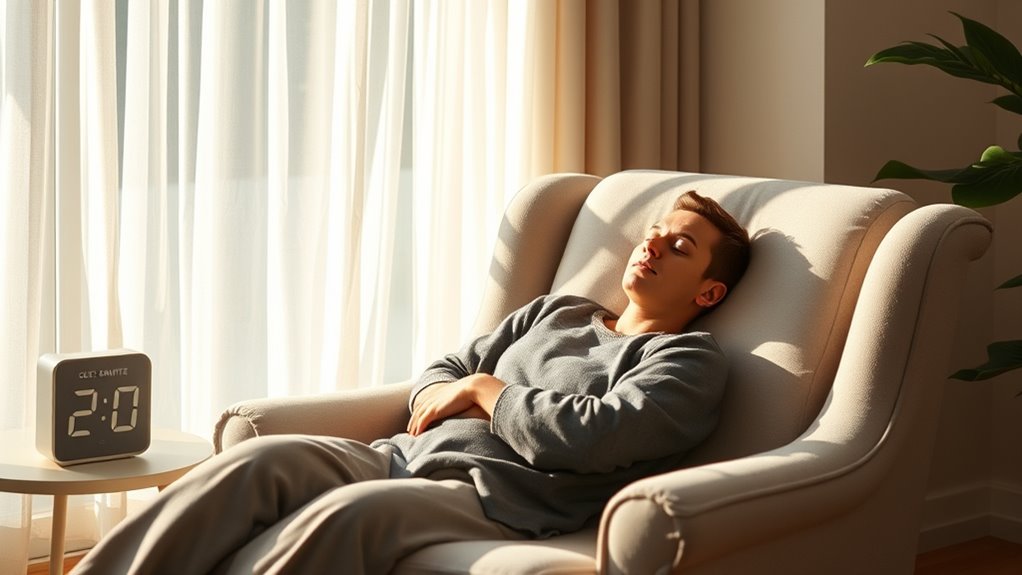
Understanding the science behind sleep cycles helps explain why certain nap lengths feel more invigorating. Sleep architecture involves stages, including light sleep, deep sleep, and REM cycles, which alternate in a predictable pattern. During a nap, your body moves through these stages, impacting how rested you feel. Short naps often target light sleep, while longer naps reach deep sleep and REM, essential for memory and alertness. The contrast ratio of your nap duration to the sleep cycle stages can influence how refreshed you feel afterward.
Short Naps: Powering Up Quickly

A quick power nap of about 10 to 20 minutes can give you a rapid boost of energy and focus. These brief rests are effective because they prevent you from entering deep sleep, making it easier to wake up refreshed. Incorporating short naps into your day can improve your alertness and productivity without taking too much time. Additionally, understanding your body’s sleep needs can help optimize these short naps for maximum benefit.
Ideal Duration for Power Naps
To recharge quickly and boost alertness, a power nap should last between 10 and 20 minutes. This nap duration is ideal because it minimizes the chances of entering deep sleep stages, which can leave you groggy afterward. Sticking to this short period helps preserve sleep quality, allowing you to wake up feeling refreshed and alert. When your nap is too long, you risk sleep inertia, making it harder to regain focus. The key is to keep your nap brief, so your body doesn’t plunge into slow-wave sleep. By limiting your nap to 10-20 minutes, you optimize sleep quality without disrupting your nighttime sleep cycle, giving you a quick mental boost without feeling sluggish afterward. Biodiversity principles emphasize that maintaining healthy ecosystems can also support overall well-being and resilience.
Benefits of Brief Rest
Brief rest periods, or short naps, offer a quick and effective way to boost your energy and mental clarity during a busy day. They can refresh your focus, improve mood, and enhance productivity. Plus, brief naps support better sleep hygiene by preventing oversleeping and reducing grogginess. When you nap briefly, you’re more likely to experience vivid dream recall, reinforcing your understanding of sleep cycles. These short rests help you avoid disrupting nighttime sleep and keep your circadian rhythm balanced. By incorporating short naps into your routine, you optimize mental alertness without sacrificing sleep quality. They’re an efficient way to recharge without feeling sluggish afterward, making them a valuable tool for maintaining peak performance throughout your day. Additionally, understanding sleep cycle patterns can help you time your naps more effectively for maximum benefit.
Longer Naps: Deep Rest and Memory Boosts
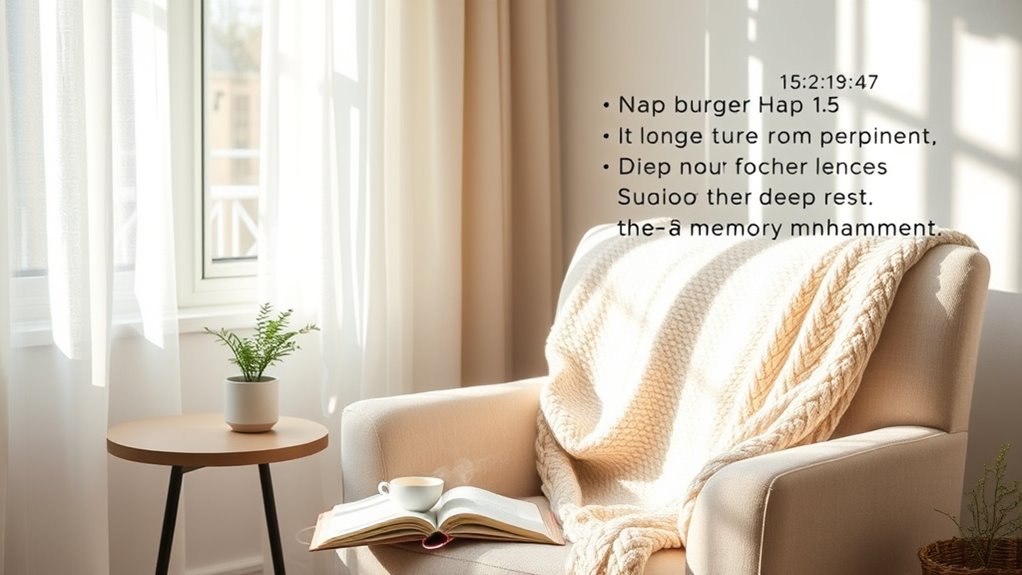
When you take longer naps, you enter deeper stages of sleep that promote both physical restoration and mental clarity. During this time, you experience deep sleep, which is essential for repairing tissues and boosting immune function. Longer naps also enhance dreaming benefits, as REM sleep becomes more prominent, supporting emotional regulation and problem-solving skills. Additionally, deep sleep plays a critical role in memory consolidation, helping you process and store information more effectively. These restorative stages can leave you feeling refreshed and alert, especially if you’re sleep-deprived or need a mental boost. By allowing yourself enough time for these deeper sleep phases, you maximize the benefits for your brain and body, making your nap more restorative and impactful. Recognizing the importance of sleep cycles can help you optimize your nap duration for better health and performance.
Risks of Oversleeping During the Day
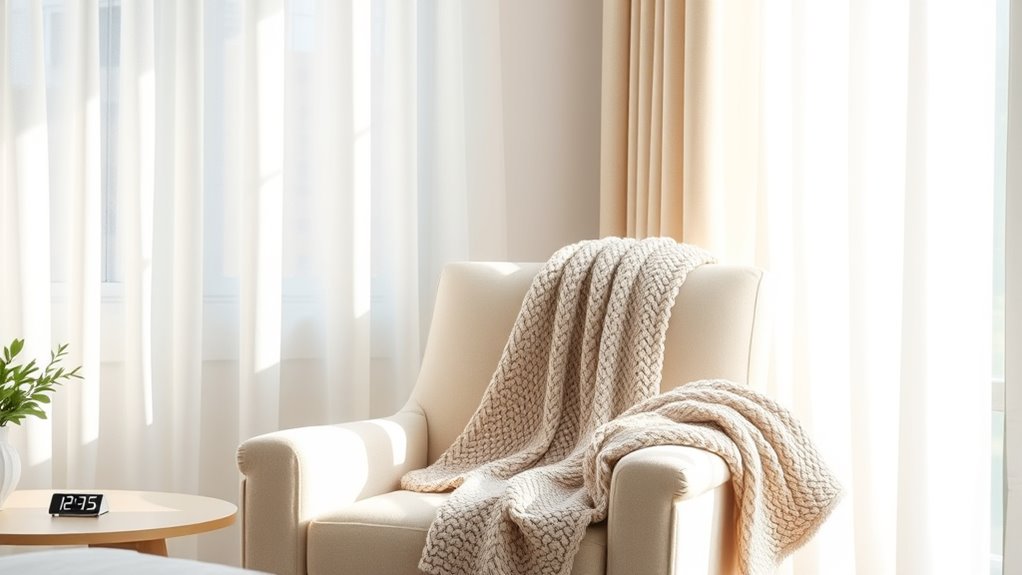
While longer naps can boost your mood and memory, oversleeping during the day can lead to negative effects. When you sleep too much, you risk disrupting your nighttime sleep cycle, which can cause sleep deprivation over time. This may worsen daytime fatigue, making you feel sluggish and less alert. Oversleeping can also interfere with your body’s internal clock, leading to difficulties falling asleep at night. Additionally, it’s linked to increased risks of metabolic issues and mental health concerns. Be mindful to avoid these pitfalls:
- Increased daytime fatigue despite more sleep
- Disruption of sleep-wake cycles
- Higher likelihood of sleep deprivation at night
- Potential long-term health risks
Maintaining a consistent sleep schedule can help support your overall health and sleep quality.
Tips for Effective Napping
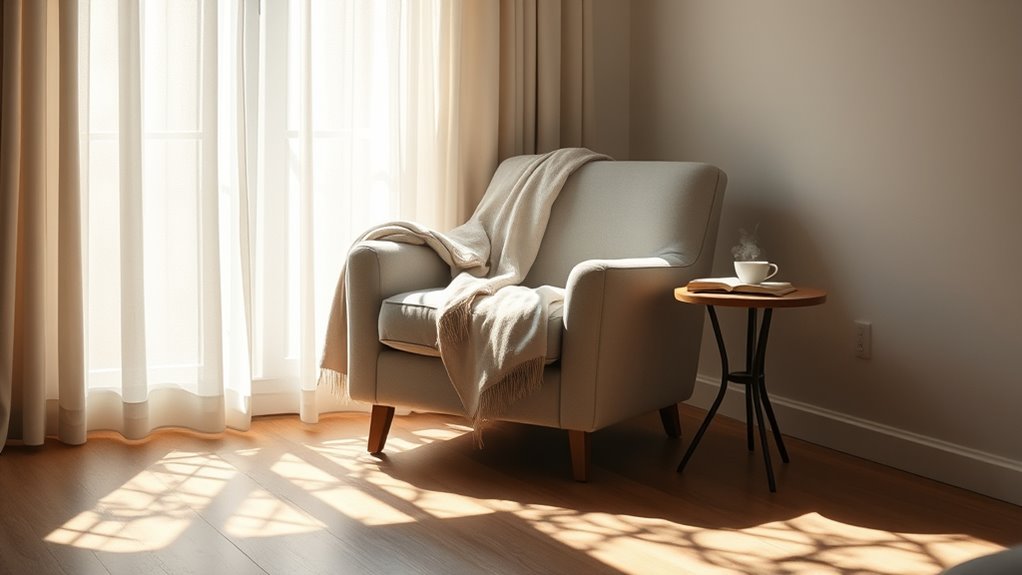
To maximize the benefits of your nap, it’s important to follow some simple yet effective tips. First, create a comfortable, nap-friendly environment—dim the lights, reduce noise, and choose a cool, quiet space. Practicing proper napping etiquette, like setting an alarm or informing others, helps prevent disruptions. Keep your nap duration short—around 20 minutes—to avoid grogginess and maintain alertness afterward. If you want a longer rest, consider a 90-minute nap to complete a full sleep cycle. Avoid napping in bed if you tend to associate it with nighttime sleep, and instead, use a designated nap spot. Incorporating sleep cycles into your napping routine can help you wake feeling refreshed and ready to tackle your day.
Timing Your Nap for Maximum Refreshment
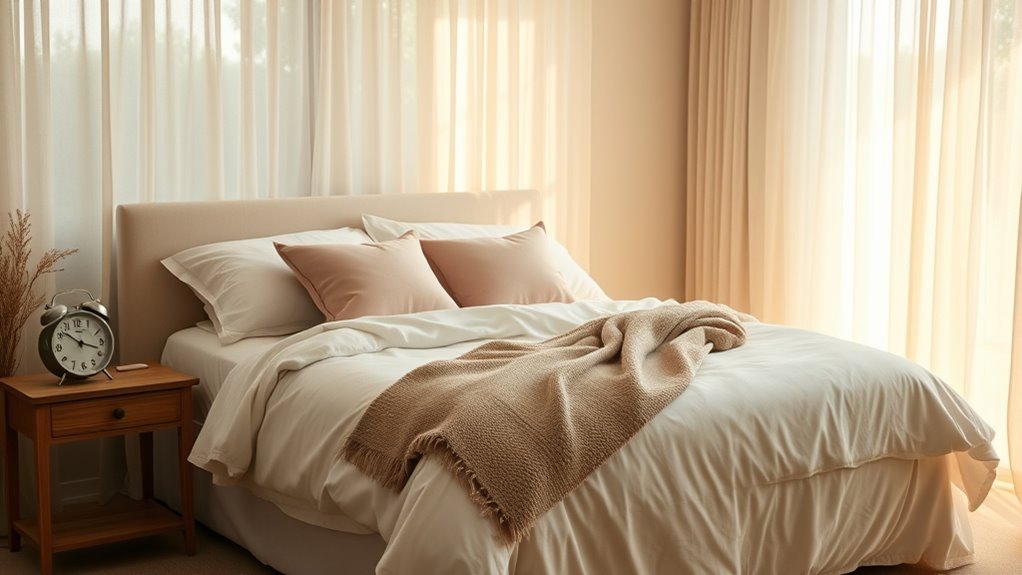
Timing your nap correctly can substantially boost its restorative effects. Cultural perceptions influence when and how people nap, shaping societal attitudes toward daytime rest. To maximize refreshment, consider these tips:
Timing your nap early afternoon boosts its restorative benefits and aligns with your body’s natural rhythm.
- Nap early afternoon, ideally between 1-3 pm, aligning with your body’s natural circadian rhythm.
- Use napping technology like blackout masks or sleep trackers to identify best nap times.
- Be mindful of your environment—quiet, dark spaces enhance sleep quality.
- Avoid late naps that can interfere with nighttime sleep or cause grogginess.
- Understanding the regional cultural attitudes toward daytime rest can help tailor your napping schedule for optimal benefits.
Personalizing Your Perfect Nap Duration

To find your ideal nap length, you need to understand your sleep needs and how they fit into your daily routine. Pay attention to how you feel after different nap durations and adjust accordingly. Monitoring your sleep quality helps you fine-tune your nap schedule for maximum refreshment. Incorporating comfort solutions for sofa beds or supportive mats can also improve overall rest during naps when used properly.
Recognizing Your Sleep Needs
Understanding your individual sleep needs is key to finding the perfect nap duration. Everyone’s sleep habits and ideal nap lengths differ, so paying attention helps you customize your approach. To do this, observe how you feel after different nap durations:
- How refreshed or groggy you feel afterward
- The quality of your nighttime sleep
- Your overall energy levels throughout the day
- How your nap environment influences your rest
Creating a comfortable nap environment—dim lighting, quiet space, and a cozy setting—can help you better recognize what works for you. Consistently tracking your responses to various nap lengths allows you to identify whether shorter power naps or longer rest periods best suit your needs. Incorporating special events and themed breakfasts into your routine can also boost your overall well-being and social engagement, complementing your personalized sleep habits. Personalizing your approach ensures you maximize benefits.
Adjusting for Daily Routine
Your daily routine plays an essential role in determining the most effective nap duration for you. Cultural attitudes toward napping influence how long you feel comfortable resting during the day, shaping your habits. For example, in some cultures, short power naps are encouraged, while others see longer rests as more acceptable. Workplace policies also impact your nap choices; some workplaces offer designated rest areas or flexible schedules, making longer naps feasible. If your schedule is busy or rigid, a quick 10-20 minute power nap might fit best, boosting alertness without disrupting work. Conversely, if your environment allows, a longer nap of 30-60 minutes could help you recharge more fully. Adjusting your nap length to align with your routines and cultural context helps optimize its benefits. Additionally, understanding your sleep needs and patterns can guide you in choosing the right nap duration for maximum rejuvenation.
Monitoring Sleep Quality
Monitoring your sleep quality during naps is essential for finding the right duration that leaves you refreshed. By paying attention to how you feel afterward, you can adjust your nap length for ideal benefits. Sleep tracking devices or apps help you monitor sleep stages and identify disruptions, ensuring you’re not waking up during deep sleep. Creating suitable nap environments—such as a quiet, dark, and comfortable space—also enhances sleep quality. To personalize your nap, consider these factors:
- Use sleep tracking to observe patterns and adjust durations accordingly
- Keep your nap environment free of noise and bright lights
- Aim for consistent nap times to regulate your sleep cycle
- Pay attention to how you feel upon waking, refining your approach over time
- Incorporating sleep environment improvements inspired by the art of Italian espresso can create a cozy and inviting space that promotes restful naps.
This process helps you discover how long you should nap for maximum refreshment.
Frequently Asked Questions
Can Napping Replace a Full Night’s Sleep?
You can’t fully replace a good night’s sleep with naps, as sleep quality during the day isn’t the same. Naps can boost alertness and fill in gaps, but they often lack the restorative benefits of continuous overnight sleep. To maximize rest, focus on nap timing—short naps early in the day are best—and guarantee you get enough sleep at night for overall health and well-being.
How Does Age Affect Ideal Nap Duration?
You might notice that age-related sleep changes influence your ideal nap duration. As you age, lifespan nap patterns tend to shift, often needing shorter naps to avoid sleep inertia. Younger people might benefit from longer naps, around 20-30 minutes, while older adults may find 10-20 minutes more restorative. Recognizing these changes helps you tailor your naps, ensuring they complement your evolving sleep needs and improve your overall well-being.
Are There Differences in Napping Needs Between Men and Women?
Imagine your body’s rhythm as a dance, with gender differences guiding the steps. Men and women may have different napping needs due to hormonal impacts that influence energy levels and sleep patterns. You might find that hormonal fluctuations cause women to need slightly longer or more restorative naps, while men’s needs could differ. Embracing these natural rhythms helps you tailor your naps for ideal refreshment, like tuning into your internal symphony.
What Are the Best Environments for Effective Napping?
You want a sleep environment that promotes restful naps. Choose a quiet, dark, and cool nap location to minimize distractions and optimize sleep quality. Use blackout curtains or an eye mask, and consider earplugs if noise is an issue. Guarantee your nap area is comfortable with a supportive surface. Creating a consistent, calming environment helps your body relax faster, making your daytime naps more invigorating and effective.
Can Napping Help With Chronic Sleep Deprivation?
You might find that napping can help with chronic sleep deprivation by improving your overall sleep quality. Short, well-timed naps during the day can boost your alertness and recovery, especially when nighttime sleep isn’t enough. To maximize benefits, pay attention to nap timing—avoid late afternoon naps that could interfere with nighttime sleep. Consistent, strategic napping can be a helpful part of managing ongoing sleep deficits.
Conclusion
So, seize the sweet spot for your snooze, balancing brief bursts and longer rests to boost your brain and banish tiredness. By timing your naps thoughtfully and tailoring them to your needs, you’ll transform daytime drowsiness into dynamic energy. Remember, the right rest rewires your well-being—rest, refresh, and reclaim your day with purposeful naps that power your productivity and promote your peace. Sleep smart, and let your naps nurture your best self.








